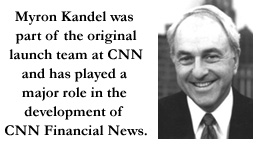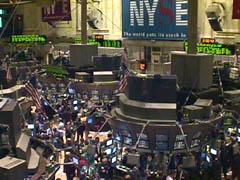|
An American success story
|
 |
December 29, 1999: 2:32 p.m. ET
CNNfn’s Myron Kandel looks back on 100 years of record economic expansion
By CNN Financial Editor Myron Kandel
|
NEW YORK (CNNfn) - The Twentieth Century became the American Century not only because of the nation’s military might, but because its free enterprise capitalist system produced the most successful economy the world has ever known.
Blessed by vast natural resources, by a dynamic work force constantly reinvigorated by waves of immigration from all corners of the globe, by a democratic political system, and by a geographic location that insulated it from most of the conflicts that ravaged other nations, the United States entered the century as a relatively young but robust newcomer to the world stage.

On Wall Street, a giant ten-year bull market was in progress, not to end until the panic of 1907. Some of the great names of American business were being created, as a wave of mergers and acquisitions swept through the corporate landscape. The biggest of all those consolidations was the creation of United States Steel, which encompassed what were once 170 separate companies.
Other empires -- or trusts -- were built in railroads, oil, tobacco and other industries. Morgan, Rockefeller and Harriman became familiar names -- even, in a mostly rural America, to people who couldn’t tell a stock from a bond.
Ironically, the great century, which began with a fast-growing economy, a stock market boom and a wave of corporate combinations, is ending on much the same note. The business landscape is much different, with an agricultural-turning-industrial economy having changed into an information-turning-global economy.
And many of the names are relatively new. There’s Microsoft and Wal-Mart, Intel and Amazon.com, Merrill Lynch and Charles Schwab.
But some of the old ones remain. There’s General Electric, still a stalwart of the Dow industrials; J.P. Morgan and Dean Witter Morgan Stanley on Wall Street, and even some pieces of the old Rockefeller oil trust are reuniting, as are some offspring of the more recent break-up of AT&T.
The war years
Two world wars, and some lesser ones, had their impact on the American scene. During World War I, New York began to supplant London as the financial capital of the world, a title it would never relinquish.
But oddly enough, it was Washington way back then that laid the seeds for the development of a new brand of people’s capitalism, which would flourish wildly in the Roaring Twenties only to be cut down by the 1929 Crash and the Great Depression of the Thirties before sprouting again in the last half of the century to a height never dreamed of before.
To pay for the "war to end all wars,” the federal government floated a series of Liberty Loan and Victory Loan issues that were bought by more than 20 million patriotic Americans. Most of them had never bought a security before, and the experience helped prepare them for participating in the stock market in the years that followed.
The economic and stock market booms of the Twenties were led by the automobile, which was transforming American business and society. Times were so good that economists began talking of a "new economy” no longer bound by the vagaries of the business cycle. But as stock prices soared, speculation -- and manipulation -- ran rampant.
Investment trusts -- the forerunner of modern mutual funds, proliferated, and many became highly leveraged just as the market was reaching its peak. Then came the calamitous crash in October 1929 that scarred a generation of investors who had poured into the market to share in its riches. From their high that year to their low in 1932, stock prices tumbled 90 percent.
The despair of the Thirties
As the country plunged into the Great Depression, the euphoria of the Twenties turned into the despair of the Thirties. The national income was cut in half and a quarter of the work force was in need of jobs.
The nation turned to the Democratic Governor of New York, Franklin D. Roosevelt, in the first of his four Presidential victories. His critics assailed the patrician FDR as "a traitor to his class” and a proponent of creeping socialism, while his supporters hailed him and his New Deal for saving the system, reforming the financial markets and creating Social Security, unemployment insurance and a host of other safety-net programs.

President Franklin D. Roosevelt was a hero to many Americans, "a traitor to his class” to others
The nation survived, revolution was averted and Americans started going back to work, but it wasn’t until the advent of World War II that the economy again began to really prosper. The United States became the arsenal of democracy and its industrial behemoth moved into high gear, producing with incredible speed the military equipment that would reverse the early victories of the Axis powers and send Germany, Japan and Italy crashing to defeat.
And a by-product of that military build-up, little noticed at the time, would have a profound impact on American life in the years ahead. It was the influx of women into the workplace, many of them in jobs they had never held before, that would set the stage for their later role on the nation’s business scene.
Economic expansion
With the war ended, the U.S. boasted the strongest economy on the globe and was the unquestioned leader of the free world, helping rebuild the shattered economies of its allies and even those of its defeated enemies. But it was challenged by the Soviet Union for military, political and ideological hegemony. A Cold War had begun, under the specter of nuclear weapons.
With ups and downs -- Korea, Vietnam, a nuclear stand-off and the space race among them -- the U.S. eventually won that war as well. Communism was discredited as a political and economic system; the Soviet Union split apart; Eastern Europe won its freedom, and former colonial nations began to emerge on the world stage.
At home, millions of servicemen came back -- to find jobs, attend college in unprecedented numbers, raise families, move to the suburbs, build highways and homes and skyscrapers, and create, with some fits and starts, a booming economy and another roaring stock market.
It was not to be a simple half-century. A President was assassinated, another resigned in disgrace, a third was impeached. Vietnam tore the nation apart. The civil rights movement awoke much of America to the injustices faced by blacks and other minorities. The stock market jumped above 1,000 for the Dow, then plunged by nearly half.
Most of the major oil-producing nations joined in a cartel that sent prices skyrocketing and even cut off oil supplies. Americans fumed in long lines at the gasoline pump and watched inflation soar and the prime interest rate hit 21 percent. The nation’s industrial heartland rusted; the auto industry slumped as imports, mainly from Japan, grabbed market share, and there were dire warnings that Japan Inc. would dominate the remainder of the century.
The Reagan era
Another big-state governor, this time a Republican, Ronald Reagan of California, came to the White House with his own brand of conservatism. Iran released the hostages it had seized at the American Embassy in Teheran; oil prices stopped rising; defense spending was increased, and the country felt better about itself and its leadership.
The Federal Reserve clamped down on inflation, under chairman Paul Volcker, and the resulting recession, though severe, was short-lived. The bad news was that the federal budget deficit climbed to undreamed-of levels and there were fears that a credit crunch would send the economy tumbling, which was not to be.

The New York Stock Exchange floor has been closely watched by Americans throughout the 20th century
The good news was that the most powerful bull market in Wall Street’s history got off to an explosive start and has thrived, with only brief interruptions, to this day. It started in August 1982, with the Dow at 776, and is now more than 10,500 points higher. In just 17 ˝ years!
That bull market survived a huge one-day market crash, in October 1987, the Iraqi invasion of Kuwait in 1990 and the brief recession it helped set off, and assorted other strains and turmoil. One of the reasons for its strength and longevity is the longest-running peacetime expansion in U.S. history -- about to become the longest expansion ever -- and President Clinton’s embrace of a long-time Republican desire to balance the budget.
So the nation embarks on another century, indeed another millennium, with an economy so strong that the only immediate worry about it is that it’s too hot, and with a stock market that keeps setting record after record for the major indexes.
At the same time, the gap between rich and poor has widened, trouble spots keep springing up around the globe, and terrorism is on the rise. But the Internet and other technological and genetic revolutions are still in their early stages, dominated so far by the American entrepreneurial spirit.
The 20th was indeed the American Century. And the United States is still well in the lead going into the 21st. 
|
|
|
|
|
 |

|

